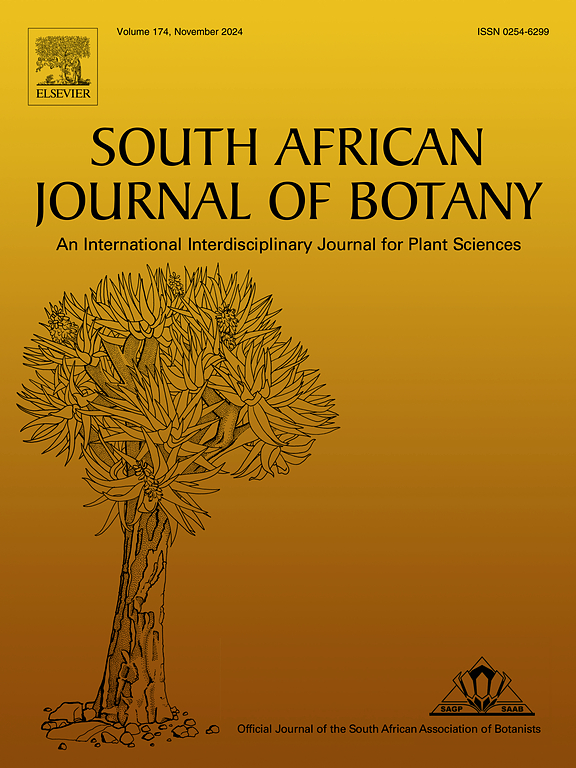四种阿尔及利亚食用植物提取物的HPLC-DAD分析、抗氧化、抗胆碱酯酶和抗糖尿病活性:体外和计算机研究
IF 2.7
3区 生物学
Q2 PLANT SCIENCES
引用次数: 0
摘要
几个世纪以来,阿尔及利亚的植物一直是药用和营养价值的丰富来源。本文研究了阿尔及利亚四种食用植物(无花果、油橄榄、大西洋黄连木)的甲醇提取物。和Zizyphus lotus L. (Desf.))的生物活性潜力。HPLC-DAD分析鉴定出多种酚类化合物。主要化合物为橄榄苦苷(335.5 mg/g),而表儿茶素(981.2 mg/g)、儿茶素(498.4 mg/g)和邻苯儿茶素(363.0 mg/g)分别为三种。莲子中主要含有芦丁(37.97 mg/g)和表儿茶素(34.35 mg/g),莲子中含有绿原酸(10.18 mg/g)和芦丁(4.88 mg/g)。采用ABTS、DPPH和CUPRAC测定法评估抗氧化活性,结果显示大西洋青霉是最有效的提取物(IC50分别为2.65、3.49和6.94µg/mL)。荷花对BChE的体外抗胆碱酯酶活性最强(IC50: 29.16µg/mL),而欧花对α-葡萄糖苷酶的体外抑制活性最强(IC50: 44.78µg/mL),在神经保护和糖尿病治疗方面具有潜在的应用前景。分子对接分析进一步支持了这些发现,强调了生物活性化合物和酶结合位点之间的关键相互作用。这些结果强调了阿尔及利亚植物作为抗氧化剂、抗胆碱酯酶和抗糖尿病药物的天然来源的治疗相关性。未来的研究将通过分离和体内实验验证其临床疗效和药物潜力。本文章由计算机程序翻译,如有差异,请以英文原文为准。

HPLC-DAD profiling, antioxidant, anticholinesterase, and antidiabetic activities of four Algerian edible plant extracts: An in vitro and in silico study
Algerian flora has been a rich source of medicinal and nutritional benefits for centuries. This study investigates the methanolic extracts of four Algerian edible plants (Ficus carica L., Olea europaea L., Pistacia atlantica Desf., and Zizyphus lotus L. (Desf.)) for their bioactive potential. HPLC-DAD analysis identified a diverse range of phenolic compounds. Mainly, oleuropein (335.5 mg/g extract) was the main compound in O. europaea, while epicatechin (981.2 mg/g), catechin (498.4 mg/g), and pyrocatechol (363.0 mg/g) were identified in P. atlantica. Additionally, rutin (37.97 mg/g) and epicatechin (34.35 mg/g) were major compounds in Z. lotus, and chlorogenic acid (10.18 mg/g) was detected alongside rutin (4.88 mg/g) in F. carica. Antioxidant activity was assessed using ABTS, DPPH, and CUPRAC assays, revealing P. atlantica as the most potent extract (IC50: 2.65, 3.49, and 6.94 µg/mL, respectively). Z. lotus exhibited the strongest in vitro anticholinesterase activity (IC50: 29.16 µg/mL against BChE), while O. europaea demonstrated significant α-glucosidase inhibitory activity (IC50: 44.78 µg/mL), suggesting potential applications in neuroprotection and diabetes management. Molecular docking analysis further supported these findings, highlighting key interactions between bioactive compounds and enzyme binding sites. These results underline the therapeutic relevance of Algerian plants as natural sources of antioxidants, anticholinesterases, and antidiabetic agents. Future studies will validate their clinical efficacy and pharmaceutical potential through isolation and in vivo experiments.
求助全文
通过发布文献求助,成功后即可免费获取论文全文。
去求助
来源期刊

South African Journal of Botany
生物-植物科学
CiteScore
5.20
自引率
9.70%
发文量
709
审稿时长
61 days
期刊介绍:
The South African Journal of Botany publishes original papers that deal with the classification, biodiversity, morphology, physiology, molecular biology, ecology, biotechnology, ethnobotany and other botanically related aspects of species that are of importance to southern Africa. Manuscripts dealing with significant new findings on other species of the world and general botanical principles will also be considered and are encouraged.
 求助内容:
求助内容: 应助结果提醒方式:
应助结果提醒方式:


